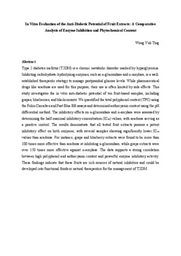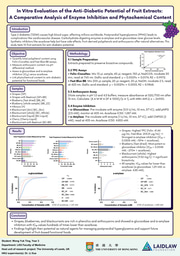Research Summary: In Vitro Evaluation of the Anti-Diabetic Potential of Fruit Extracts: A Comparative Analysis of Enzyme Inhibition and Phytochemical Content
Introduction:
Type 2 diabetes (T2DM) causes high blood sugar, affecting millions worldwide. Postprandial hyperglycemia (PPHG) leads to complications like cardiovascular disease. Carbohydrate-digesting enzymes α-amylase and α-glucosidase raise glucose levels. Synthetic inhibitors like acarbose help but have side effects. Fruit-derived polyphenols and anthocyanins offer natural alternatives. This study tests 10 fruit extracts for anti-diabetic potential.
Objective:
- Quantify total polyphenol content using Folin-Ciocalteu and Fast Blue BB assays.
- Measure anthocyanin content via pH differential method.
- Assess α-glucosidase and α-amylase inhibition (IC₅₀) versus acarbose.
- Link phytochemical content to anti-diabetic potential for functional foods.
Samples:
- Grapes (GP)
- Grapes with Beetroot (GP+BR)
- Blueberry (fast dried) (BB_W)
- Blueberry (whole sample) (BB_ZZ)
- Hibiscus (H)
- Blackcurrant (skin) (BC_Skin)
- Blackcurrant (whole) (BC_Whole)
- Blackcurrant (liquid) (BC-Liquid)
- Cherry (Cherry-Liquid)
- Blackcurrant with Beetroot (BC-BR)
Methodology:
3.1 Sample Preparation
Extracts prepared to preserve bioactive compounds.
3.2 TPC Assays
- Folin-Ciocalteu: Mix 10 µL sample, 40 µL reagent, 150 µL Na2CO3; incubate 30 min; read at 765 nm. Gallic acid standard: y = 0.0029x + 0.0174, R2 = 0.9972.
- Fast Blue BB: Mix 200 µL sample, 20 µL reagent, 20 µL NaOH; incubate 2 h; read at 420 nm. Gallic acid standard: y = 0.0029x + 0.0553, R2 = 0.9868.
3.3 Anthocyanin Assay
Dilute samples in pH 1.0 and 4.5 buffers; measure absorbance at 520/700 nm after 15 min. Calculate: (A × M W × DF × 1000)/(ϵ × 1), with MW=449.2, ϵ = 26900.
3.4 Enzyme Inhibition
- α-Glucosidase: Pre-incubate with enzyme (0.5 U/mL, 10 min, 37°C); add pNPG (2.5 mM); monitor at 405 nm. Acarbose IC50: 1.287 mM.
- α-Amylase: Pre-incubate with enzyme (1 U/mL, 10 min, 37°C); add CNPG3 (2 mM); read at 405 nm. Acarbose IC50: 4.853 mM.
Results:
- Grapes: Highest TPC (Folin: 41.44 μg/mL; Fast Blue: 203.31 μg/mL) → Strongest α-amylase inhibition (IC₅₀ = 0.0305 mM, ~159× < acarbose).
- Blueberry (fast-dried): Most potent α-glucosidase inhibitor (IC₅₀ = 0.0048 mM, ~270× < acarbose).
- Blackcurrant (whole): Highest anthocyanins (9.52 mg/L) → significant bioactivity.
- All samples: IC₅₀ values far lower than acarbose (α-glucosidase: 1.29 mM; α- amylase: 4.85 mM).
Conclusion:
- Grapes, blueberries, and blackcurrants are rich in phenolics and anthocyanins and showed α-glucosidase and α-amylase inhibition with IC₅₀ values hundreds of times lower than acarbose.
- Findings highlight their potential as natural agents for managing postprandial hyperglycemia and support future development of fruit-based functional foods.


Please sign in
If you are a registered user on Laidlaw Scholars Network, please sign in